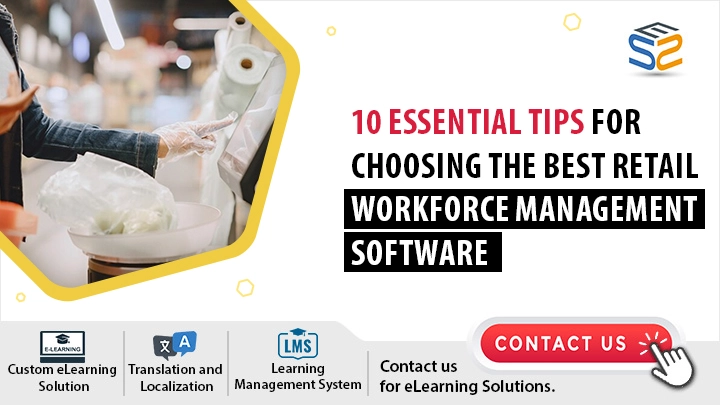Introduction
electing the best retail workforce management software is a crucial decision for enhancing efficiency and productivity in retail operations. With various software solutions available, finding the right fit for your business requires careful consideration. This guide provides ten essential tips to help you make an informed choice, ensuring that your software selection meets your specific needs and supports your operational goals.
What is Retail Workforce Management Software?
Retail workforce management software is designed to streamline and optimize the management of employees in a retail setting. It encompasses a range of functionalities, including scheduling, time tracking, payroll processing, and compliance management. The goal of this software is to improve operational efficiency, reduce labor costs, and ensure that your workforce is effectively managed and compliant with labor regulations.
Why Workforce Management Software Matters
Workforce management software isn’t just a luxury—it’s a necessity for modern retail operations. From scheduling and attendance tracking to payroll and compliance, the right software can help you manage your workforce efficiently and effectively.
Key Features to Look For
Before diving into the sea of available options, make sure to look for these key features in any software you consider:
- Scheduling: Create and manage employee schedules effortlessly.
- Time Tracking: Accurate tracking of hours worked.
- Payroll Integration: Seamless connection to payroll systems.
- Compliance Management: Tools to help with labor laws and regulations.
1. Assess Your Retail Needs
Before diving into software options, evaluate your unique retail requirements. Consider factors such as team size, scheduling complexity, time tracking needs, and payroll management. Understanding these requirements will help you identify the software that best aligns with your business objectives and operational demands.
2. Prioritize User-Friendly Interfaces
The usability of the software is critical for both managers and employees. A user-friendly interface ensures that the system is easy to navigate and requires minimal training. Look for software with intuitive dashboards, straightforward navigation, and clear instructions to facilitate a smooth user experience.
3. Evaluate Integration Capabilities
Effective integration capabilities are essential for seamless operations. The software should integrate with existing systems such as point-of-sale (POS) systems, HR software, and payroll services. Integration minimizes manual data entry, enhances accuracy, and streamlines various aspects of workforce management.
4. Look for Robust Scheduling Features
Scheduling is a core component of workforce management. Opt for software with robust scheduling features that support easy creation, modification, and distribution of schedules. Features like drag-and-drop scheduling, shift swapping, and automated scheduling based on employee availability can save time and reduce scheduling conflicts.
5. Ensure Compliance Management
Retail businesses must adhere to various labor laws and regulations. Choose software with built-in compliance management features to help you stay within legal requirements regarding overtime, break times, and scheduling practices. This will help you avoid potential legal issues and fines.
6. Focus on Real-Time Analytics and Reporting
Data-driven insights are vital for optimizing operations. Look for software that provides real-time analytics and reporting capabilities. These tools enable you to monitor key metrics such as labor costs, employee performance, and attendance trends, allowing you to make informed decisions quickly.
7. Consider Mobile Accessibility
In the retail environment, mobility enhances flexibility. Ensure the software offers mobile accessibility so that managers and employees can access schedules, request time off, and communicate from their smartphones. This feature improves communication and operational efficiency, especially for a dispersed workforce.
8. Review Scalability Options
As your retail business grows, your software needs will evolve. Choose software with scalability options that can expand with your business. Look for the ability to add more users, integrate additional features, or connect with other systems as your operations expand.
9. Check for Support and Training
Effective customer support and training resources are crucial for smooth software implementation and use. Investigate the support options offered by the software vendor, including online tutorials, live chat, phone support, and user forums. Quality support ensures a positive experience and resolves issues efficiently.
10. Compare Costs and ROI
While cost is an important consideration, it should be weighed against the potential return on investment (ROI). Compare the pricing models of different software options, including upfront costs, subscription fees, and additional costs for features or support. Assess how the software’s benefits, such as improved efficiency and reduced labor costs, contribute to the overall ROI.
Conclusion
Choosing the right retail workforce management software is a critical decision that can impact your business’s efficiency and productivity. By understanding your needs, evaluating scalability, checking integration capabilities, and more, you can make an informed choice that aligns with your goals. Remember, a good fit today can save you time and effort in the long run, allowing you to focus on what really matters-running your retail business smoothly.
Frequently Asked Questions (FAQs)
Q1. What is retail workforce management software?
A. Retail workforce management software helps retailers manage employee scheduling, time tracking, payroll, and compliance tasks. It aims to enhance operational efficiency and ensure legal compliance.
Q2. How does workforce management software benefit retail businesses?
A. This software optimizes scheduling, reduces labor costs, boosts employee productivity, and maintains compliance with labor laws. It also improves communication and streamlines workforce management tasks.
Q3. Can retail workforce management software integrate with my existing systems?
A. Yes, many solutions offer integration capabilities with existing systems such as point-of-sale (POS) systems, HR software, and payroll services. Ensure the software you choose is compatible with your current systems.
Q4. Is mobile accessibility important in retail workforce management software?
A. Yes, mobile accessibility is crucial as it allows managers and employees to manage tasks from smartphones. It enhances flexibility, improves communication, and supports a distributed workforce.
Q5. What should I consider when evaluating the cost of workforce management software?
A. Consider the upfront price, subscription fees, and additional costs for extra features or support. Compare these costs against potential savings in labor and improvements in efficiency to assess the return on investment (ROI).




